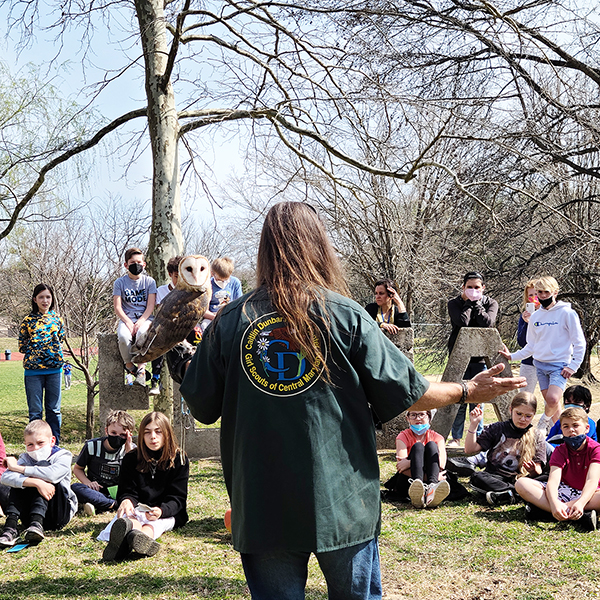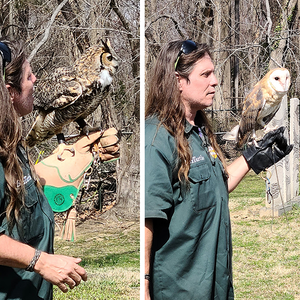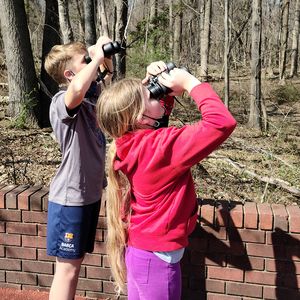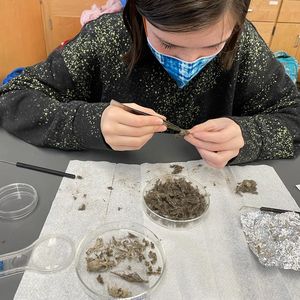STEM: A Raptors Session

An outdoor class in late March was led by Mr. Billy Heinbuch, a licensed raptor handler, wildlife rehabilitator and the director of Nature programs for the Girl Scouts of Central Maryland at their center in Ellicott City, Maryland where he is the resident naturalist.
Mr. Heinbuch began the field biology session for 5th and 6th graders by asking if anyone present had ever seen a dinosaur, then pointed out that birds are descendants of the extinct reptile with skeletons recognizably similar to those displayed at the Museum of Natural History. The word, raptor, he explained, describes a creature that can swiftly grab prey, playing an important role in rodent control. He passed around a dried hawk’s foot while describing the remarkable mechanics of the raptor’s main weapon, feet with talons that allow the bird to strike and lock onto its prey with great force.
Oohs and Wows greeted each new revelation.
Then things got more exciting as he opened a nearby cage and introduced Nera, a Broad-wing hawk, roughly the size of a crow but with a broader 800 cm wingspan; its camouflage mix of feather coloration and body structure, he explained, are a big advantage to a high-speed hunter.
A raptor like Nera, the naturalist explained, breeds in northern mountain forests during the breeding season where flying at high speed enables it to capture rodents and other prey. In Fall it is commonly seen at higher altitudes as it joins thousands of other Broad-winged hawks soaring along mountain ridges on their long flight south to southern Brazil and Uruguay. There they spend the winter before beginning the long return flight to their breeding grounds across the mountain forests of the northern states and Canada.
Then Mr. Heinbuch brought out a Great Horned Owl named Squint, who immediately launched into a low volume greeting of soft rhythmic hoots. “Horned” in this instance, the students learned, merely refer to the large predator’s feathered ear tufts. Friendly as the human-raised Squint may seem, the naturalist commented, Great-horned owls are nighttime hunters who are at the top of the bird world – the “apex predator” across most of North America, the most aggressive and wide-ranging raptors of all. Their prey menu includes rodents, rabbits and hares, ducks and other medium to large sized birds – including Osprey and other owls, the young of many mammals including raccoons, and occasionally adult skunks.
The students learned that this owl’s two eyes alone fill most of the bird’s skull, enabling sharp vision to detect prey at great distances. Because one eye is set slightly higher in its head than the other, the bird can triangulate – visually place the prey-target precisely, before it strikes.
The third and last raptor was a Barn Owl named Storm, another nighttime hunter whose dramatic oval face, the students learned, formed a dish-shaped receiver of sound, with hearing so sensitive that this owl could detect and strike mice in total darkness. This light-colored bird showed keen interest in everyone, rotating and craning it head. Students cheered when it coughed up a pellet, the dense mass of fur and bone that remains after prey is swallowed whole and the raptor’s digestion has removed the nutrients.
The students’ delight with Mr. Heinbuch’s exciting facts and humor was expressed afterwards in notes to him urging a return session with more creatures, including “rescued snakes, turtles and bugs.” Of the three birds, the Barn Owl was the favorite, drawing comments on its hearing, dramatic appearance and “cute” demeaner while being handled by the skilled naturalist.
The raptor session was part of the extracurricular STEM program, which among other things aims to reintroduce native bird species to the school campus. If you would like to support the naturalist AGs, for example by donating used or new binoculars, please contact scolopy@giswashington.org .
Thank you.
Steffi Colopy
(STEM-Coordinator)













